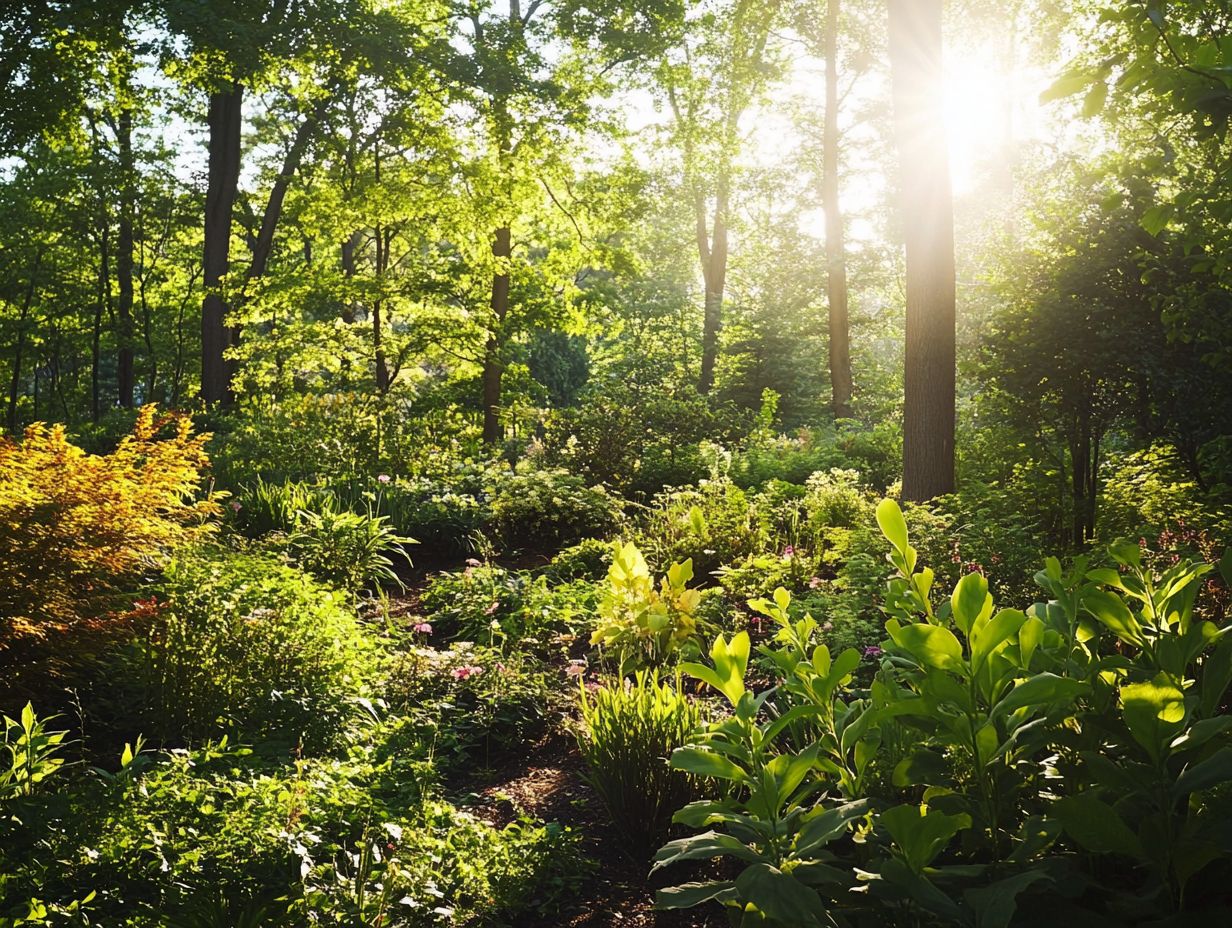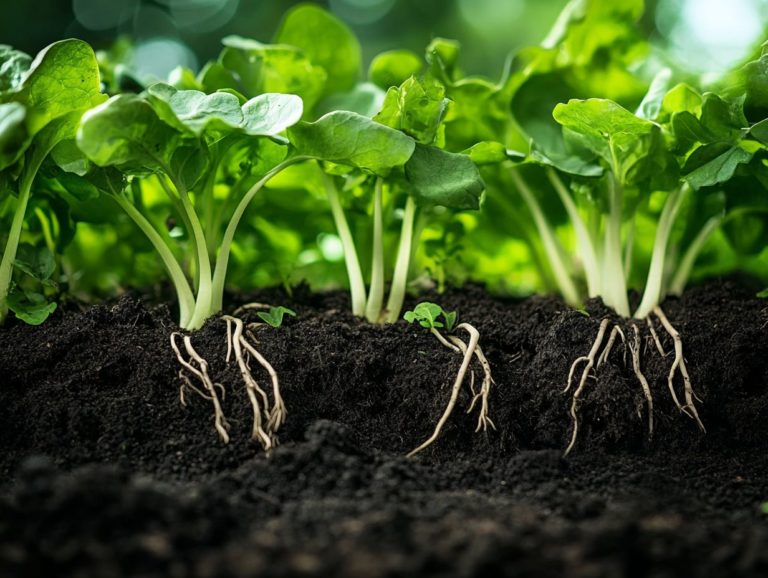What is Forest Gardening in Permaculture?
Forest gardening combines agriculture and ecology. It takes inspiration from the designs of natural forests.
This method encourages you to craft diverse and productive landscapes that reflect nature s patterns. Ultimately, this leads to sustainable food production and enriched biodiversity, creating a lush, abundant oasis.
You will discover the fascinating origins of forest gardening and delve into its principles grounded in permaculture. You ll uncover the myriad ecological and personal benefits it brings.
You will also learn how to design, implement, and maintain your own forest garden for long-term success. Whether you re a seasoned gardener or just beginning your journey, there s valuable insight here for anyone eager to cultivate a greener future and establish their own backyard food forests.
Contents
- Key Takeaways:
- Principles of Permaculture in Forest Gardening
- Benefits of Forest Gardening
- Designing and Implementing a Forest Garden
- Maintaining and Harvesting from a Forest Garden
- Frequently Asked Questions
- What Is Forest Gardening?
- How Does Forest Gardening Differ from Traditional Gardening?
- What Are the Benefits of Forest Gardening?
- Can Anyone Practice Forest Gardening?
- What are some key considerations when planning a Forest Garden in Permaculture?
- Is Forest Gardening in Permaculture environmentally friendly?
Key Takeaways:

- Forest gardening mimics natural ecosystems.
- It enhances soil health and conserves resources.
- Successful design requires careful planning of key elements.
Defining Forest Gardening and its Origins
Forest gardening is an elegant and sustainable agricultural practice that mirrors the beauty of natural ecosystems. Imagine a biodiverse landscape where trees, shrubs, and herbs coexist harmoniously, supporting a rich tapestry of plants and wildlife.
This technique draws inspiration from ancient food forest concepts. Societies in regions like Costa Rica and Morocco cultivated systems that balanced human needs with nature, showcasing the importance of restoration agriculture. These early civilizations understood the vital role of biodiversity and designed their landscapes to flourish as vibrant ecosystems, offering sustenance, shelter, and habitats for diverse creatures.
Influential figures, such as Joe Hollis, have breathed new life into these timeless practices. Joe shares insights on creating thriving gardens. By embracing forest gardening, you connect deeply to the land and promote stewardship and sustainability that resonate through generations.
Principles of Permaculture in Forest Gardening
The principles of permaculture in forest gardening emphasize creating sustainable yields through thoughtful plant interactions, including “nitrogen fixers,” which are plants that improve soil health by adding nitrogen, and detoxifiers. By ensuring every layer of your garden serves multiple functions, you foster a thriving ecosystem.
This involves integrating nitrogen fixers and detoxifiers while strategically employing companion plants and polycultures, leading to more productive outcomes. Such practices enhance biodiversity and contribute to a resilient food forest, making your gardening efforts effective and rewarding.
Join the movement towards greener living today by starting your very own forest garden!
Applying Sustainable Design Principles
Applying sustainable design principles to establish your permaculture food forest involves choosing low-maintenance perennials and utilizing methods that restore the land. This approach creates a vibrant oasis that flourishes with minimal intervention and embodies the principles of paradise gardening.
Conducting a thorough site analysis is crucial in this endeavor. It helps you identify the unique climate, soil conditions, and sunlight patterns that will guide your plant selections. By intentionally choosing native plant species suited to your local environment, you can cultivate a resilient ecosystem. This reduces reliance on irrigation and pest control, enhancing the overall productivity of your permaculture food forest.
A well-thought-out layout that incorporates layering featuring taller trees, medium shrubs, and ground cover will naturally promote biodiversity and encourage connections between organisms. These connections lead to healthier soil and increased yields. This thoughtful design enhances the natural beauty of your landscape while ensuring a self-sustaining environment that thrives over time, reflecting the ethos of sustainable yields.
Benefits of Forest Gardening

Forest gardening presents a wealth of benefits that go beyond mere food production. It cultivates a vibrant and diverse ecosystem and enriches community well-being. It plays a crucial role in enhancing ecological health through improved biodiversity and habitat restoration, both vital for community gardens.
As urban areas increasingly seek sustainable solutions, community food forests emerge as vital assets. They promote local food systems and strengthen social connections among residents, leading to a more resilient community.
Environmental and Personal Benefits
The environmental and personal benefits of forest gardening are truly impressive. You create a thriving ecosystem that supports pollinators and beneficial insects while offering you a tranquil space to connect with nature and enhance your well-being.
This practice creates a rich variety of plant and animal species, providing vital habitats for wildlife. It also fosters a sense of community as you and others come together to cultivate and care for these lush green spaces. Get ready to enjoy the physical activity involved, which promotes better health and enhances your mental well-being through stress relief and mindfulness.
By engaging in sustainable practices, you help preserve the environment. You gain the dual rewards of enriching your surroundings while nurturing your own body and mind.
Designing and Implementing a Forest Garden
Designing and implementing a forest garden requires a thoughtful approach that embraces the permaculture design process. This ensures you maximize your space and time while establishing a foundation for a productive backyard food forest, filled with nutrient-rich seeds and compost.
Key Elements and Considerations
Key elements and considerations for establishing your forest garden revolve around understanding the various layers of function that different plants provide. Companion plants and polycultures can significantly enhance both productivity and ecosystem health.
To cultivate a thriving forest garden, it s essential to recognize the different canopy layers from towering trees to low-growing ground cover each contributing uniquely to the system. This thoughtful stratification optimizes your available space and promotes beneficial interactions among plants.
For example, by integrating nitrogen-fixing species with your fruit-bearing trees, you can elevate soil fertility. Incorporating aromatic herbs can help keep pesky intruders at bay. Implementing maintenance strategies like mulching and periodic pruning is key to preserving the health of your diverse plant community. This creates an ecosystem where wildlife and beneficial insects can flourish.
Ultimately, this approach leads to a resilient and productive garden that offers both beauty and bounty.
Maintaining and Harvesting from a Forest Garden

Maintaining a forest garden requires sustainable strategies that maximize yields. Focus on low-maintenance perennials that provide reliable food sources with minimal effort.
Best Practices for Long-Term Success
Using food seeds and compost wisely enhances soil health and plant resilience. Integrating plants that naturally add nitrogen can create a thriving ecosystem.
Regular soil testing offers insights into nutrient needs. With this knowledge, you can make targeted amendments to boost plant growth.
Companion planting enhances natural pest resistance and increases pollination. Seasonal practices like winter mulching and crop rotation improve moisture retention and soil structure.
By promoting biodiversity with various native plants, you attract beneficial insects vital for your garden’s health and productivity.
Frequently Asked Questions
What Is Forest Gardening?
Forest gardening is a sustainable approach to gardening that imitates a natural forest ecosystem. It involves growing diverse plants that support each other, creating a self-sustaining system.
How Does Forest Gardening Differ from Traditional Gardening?

Unlike traditional gardening, forest gardening minimizes the need for fertilizers and pesticides. It relies on natural interactions between plants, animals, and microorganisms.
What Are the Benefits of Forest Gardening?
Forest gardening improves soil health, boosts biodiversity, and reduces water use. It offers a variety of edible and medicinal plants while requiring less maintenance.
Can Anyone Practice Forest Gardening?
Yes, anyone can practice forest gardening, regardless of experience. It adapts to various climates, from Costa Rica to Vietnam, with many resources available to help beginners.
What are some key considerations when planning a Forest Garden in Permaculture?
When planning a forest garden, consider the site s climate, soil conditions, and resources. Selecting and arranging companion plant polycultures creates beneficial relationships and maintains ecosystem balance.
Using nitrogen-fixing plants and detoxifiers can boost soil health. This supports a diverse and thriving garden.
Is Forest Gardening in Permaculture environmentally friendly?
Yes! Forest gardening is an environmentally friendly method that promotes sustainability and conserves natural resources. It helps reduce issues like soil erosion and chemical pollution, contributing to a healthy ecosystem.
This approach also aligns with the ideas behind restoration agriculture. It creates edible forest gardens spaces that grow food while nurturing biodiversity.






